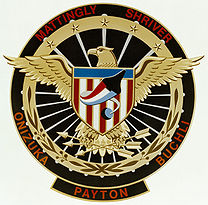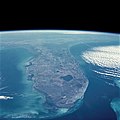STS-51-C
| Missionsemblem | |||||
|---|---|---|---|---|---|
 | |||||
| Missionsstatistik | |||||
| Missionsnavn: | STS-51-C | ||||
| Rumagentur: | NASA | ||||
| Rumfærge: | Discovery (15) | ||||
| Affyringsrampe: | LC-39A (KSC) | ||||
| Opsendelse: | 24. januar 1985 | ||||
| Landing: | 27. januar 1985 | ||||
| Landet på: | KSC | ||||
| Varighed: | 3 dage, 1 time | ||||
| Foto af besætningen | |||||
 | |||||
| Navigation | |||||
| |||||
STS-51-C (Space Transportation System-STS-51-C) var rumfærgen Discoverys 15. rumfærgeflyvning. Opsendt 24. januar 1985 og vendte tilbage den 27. januar 1985.
Det var første mission for Forsvarsministeriet (USA) (DoD), missionens formål var derfor hemmelig.
Det menes at der blev sat spionsatellitter i kredsløb, muligvis en Magnum ELINT der er i stand til at aflytte elektroniske signaler[1].
Besætning

 Ken Mattingly (kaptajn)
Ken Mattingly (kaptajn)
 Loren Shriver (pilot)
Loren Shriver (pilot)
 Ellison Onizuka (missionsspecialist)
Ellison Onizuka (missionsspecialist)
 James Buchli (missionsspecialist)
James Buchli (missionsspecialist)
 Gary Payton
Gary Payton
Missionen
Hovedartikler:
| Wikimedia Commons har medier relateret til: |
Eksterne henvisninger
- STS-51-C Arkiveret 16. oktober 2008 hos Wayback Machine NASA (engelsk)
- ^ Magnum Chronology www.astronautix.com
| ||||||||
| ||||||||||||||||||||
Medier brugt på denne side
Forfatter/Opretter: Kwamikagami, Licens: CC BY-SA 4.0
symbol of Mars. 16 × 16 pixel nominal dimensions, lines 2 pixel thick, square caps. Colour 75% blue: red=0 green=0 blue=191 (#0000BF).
Rotated and color enhanced version of original (ISS013-E-48788 (6 July 2006) --- The Space Shuttle Discovery approaches the International Space Station for docking but before the link-up occurred, the orbiter "posed" for a thorough series of inspection photos. Leonardo Multipurpose Logistics Module can be seen in the shuttle's cargo bay. Discovery docked at the station's Pressurized Mating Adapter 2 at 9:52 a.m. CDT, July 6, 2006.)
SVG version of PNG Space Shuttle Logo/Patch.
The crew insignia for STS Flight 51-C includes the names of its five crewmembers. The STS 51-C mission marked the third trip of the Space Shuttle Discovery into space. It was the first Space Shuttle mission totally dedicated to the Department of Defense. The U. S. Air Force Inertial Upper Stage Booster Rocket was successfully deployed. Due to the nature of the mission, few additional details of the flight were made available. Landing was made at the Kennedy Space Center, FL on January 27 at 4:23 PM EST. Mission duration was three days, one hour and 33 minutes.
The Gulf of Mexico and the Gulf Stream bracket the Florida Peninsula on the west and east. The lighter shade of blue in the Gulf of Mexico is due to the much shallower (continental shelf) water depths of less than 200 feet (60 meters), whereas the much darker blue of the Gulf Stream is due to water depths in excess of 2000 feet (610 meters). Tampa Bay and Charlotte Harbor are fairly large water embayments along the west coast, and Lake Okeechobee is the large body of water in the south-central part of the state. Numerous smaller lakes can also be seen generally extending north and south through the central part of the state. Practically all of the lakes in central Florida have been created by the interaction of water with the limestone rock that underlies most of the state. Thus, through time, sinkholes have developed, occasionally swallowing houses and roads as the limestone rock collapses. This type of topography is termed "karst." Visible along the southeastern coast of Florida is a large urban area that stretches roughly from Homestead in the south to beyond West Palm Beach in the north (including the greater Miami area). This built-up area is known as the "Gold Coast" of Florida. To the west of this vibrant and ever-growing urban area is the vast, relatively uniform-looking swampland of the Everglades, which is virtually uninhabited by humans. In fact, most of the flat, saw grass landscape is occasionally interrupted by small stands of hardwood hammocks; this area is part of the Big Cypress National Preserve and the Everglades National Park. Most of the Florida Keys are visible as they form an archipelago that arcs to the southwest from the southern tip of Florida. Also visible are parallel lines of clouds that have been formed as a cool air mass from the northwest is pushed across the warmer water of the Gulf Stream. A very faint smoke plume that originates near the Georgia-South Carolina border provides a clue to the wind direction at the time this photograph was taken.
The crew assigned to the STS-51C mission included (kneeling in front left to right) Loren J. Schriver, pilot; and Thomas K. Mattingly, II, commander. Standing, left to right, are Gary E. Payton, payload specialist; and mission specialists James F. Buchli, and Ellison L. Onizuka. Launched aboard the Space Shuttle Discovery on January 24, 1985 at 2:50:00 pm (EST), the STS-51C was the first mission dedicated to the Department of Defense (DOD).
STS-51A Mission Insignia
- The Space Shuttle Discovery en route to Earth orbit for NASA's 51-A mission is reminiscent of a soaring Eagle. The red and white trailing stripes and the blue background, along with the presence of the Eagle, generate memories of America's 208 year-old history and traditions. The two satellites orbiting the Earth backgrounded amidst a celestial scene are a universal representation of the versatility of the Space Shuttle. White lettering against the blue border lists the surnames of the five-member crew.












